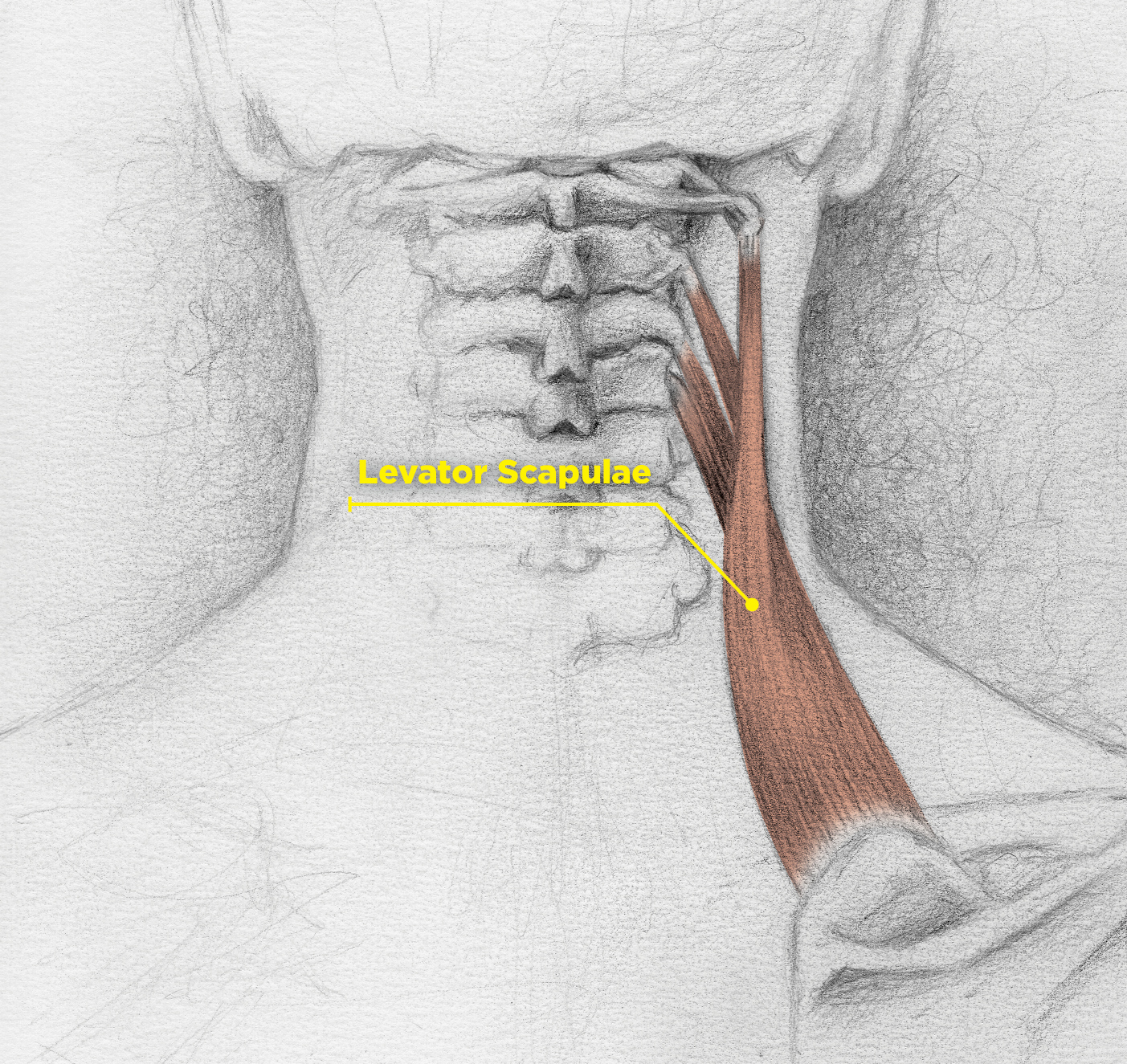Levator Scapulae
We return to the levator scapula muscle today. It extends from your shoulder blade and attaches to the upper four bones of your neck. People complain to me on a weekly basis about their pain that traverses along the levator scapulae from the shoulder blade to the neck.
Your neck will not turn as far as it could when you have a tight levator scapulae. In addition, this muscle frequently produces headaches.
The scapular attachment of the levator scapulae lies just out of reach of most people’s ability to grab onto. You can massage the neck portion of the muscle, but the part located on the shoulder blade is another matter. It stays tight and continues to pull on your upper neck muscles.
Other Self-Help Treatments to Loosen the Levator Scapulae.
The hooked Therapy Cane works wonders for many muscles. The difficulty with the levator scapulae is that you ironically contract the very muscle you are trying to relax when you lift the Therapy Cane to get it into position.
The levator scapulae does what its name implies. It raises your shoulder blade. You do not want your shoulder blade raised when your neck is tight. Instead, you want it lowered to relieve neck tension.
You try to position the cane hook on the muscle. However, but you find your shoulder blade does not stay still enough for you to target it. Some canes work better than others.
People lean again objects such as tennis balls or doorframes to put pressure on the muscle. Unfortunately, the curvature of the upper back as it transitions into the neck make it difficult to get a fix on the area that needs the pressure.
Try This! Press the Clavicular Head of the Pectoralis Major.
In simple, non-Latin English, look for the area just under the middle part of your collar bone. Yes, this area will be tender. Persevere for about 15-30 seconds.
Do not bother to attack the levator scapulae directly. You have done that before. You can beat it by subterfuge. These points to release the levator scapulae are on the front of your upper chest, not on your back shoulder blade.
As a result, when zero in on the target area in the underside of the collarbone, a strange thing may happen. The tenderness and tightness in the levator scapulae muscle can lighten.
“That’s Crazy!”
Suddenly you can turn your neck farther! Any treatment that elicits the response from my clients such as “you’re kidding!” or “how can this work?!” or “that’s crazy” tells me we are on the right track with this collarbone pressure treatment.
Simply rub the area under your collarbone for about 30 seconds, maintaining pressure on the areas that are most tender. You may be surprised to realize the solution to your neck and headache problem was in easy reach of your hands all along.
Headaches Can Get Better, Too.
Push the area under your mid-collar bone, which loosens the levator scapulae, which loosens the tendrils attached to your neck, which reduces your headache because the neck tendrils quit gripping so firmly and stop sending pain impulses to your head.
This chain reaction relief is one example which shows how interconnected your body is.
Are Other Neck Muscles Involved?
Other neck muscles may well loosen up at the same time as the levator scapulae. I believe the levator scapulae is the main troublemaker which is released with this technique.
Cautions
Bypass this treatment if you on blood thinners, as you could get excess bruising. Clear with your doctor if you have any other conditions such as a collarbone fracture that would give you pause before proceeding.
You Have the Control
Consider the use of this gentle indirect treatment for your neck muscle relaxation rather than the harsher direct neck-cracking approach. As I discussed with a client not too long ago, “Why go to have your neck cracked when you can just rub your collarbone and get your neck turning better?” “Really!” she replied. This easy treatment puts control of your problem in your hands, not someone else’s!
-You understand that if not done properly, some techniques and exercises described in this blog could harm you. Any activities you perform are at your own risk, and you expressly agree to waive any claims against the author for any harm that may arise from your own actions. By reading this blog and conducting these exercises, you accept this risk. This blog provides content related to physical and/or mental health issues. As such, your use of techniques described acts as your acceptance of this disclaimer. Consult Chapter 2 in my book, “Calming the Headache Storm” to make sure the headache is not the sign of a more serious problem. The techniques, advice and strategies contained in this blog may not be suitable for every individual and should be abandoned if your headache increases. Seek the advice of your physician.
